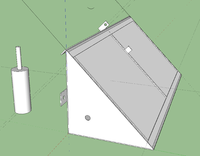Andrew Graham Log
Ideas to implement
- Build a workflow in Houdini to dynamically build a dxf with dimensioning and instructions for fabrication - Build a procedural animation tool to follow a spreadsheet for construction order. The result from houdini would be an open GL animation of the build of the model.
13th March, 2014
Updated cad file and range of motion. Added hinges and correct thicknesses. http://opensourceecology.org/wiki/Soil_Mixer_-_Overall_Machine_-_3D_CAD
Collaboration notes: setting up remote collaboration for the design process in solid works can be aided by a synchronized web folder to users local paths. drop box achieves this but has a size limit. we need software that can do that locally to a raid array with offsite backup. Eric Potash suggested aero fs https://www.aerofs.com
Lime wash
Determined that the 4 parts lime/3 parts water then salt added (salt is 1/5th the lime amount by volume, not weight) is a good mix provided the surface is smooth. On a rough surface this mix is too thick. If the mix is too thick it can crack due to shrinkage after drying. For a rough surface, this mix instead works - 1 part lime / 1 part water by volume, with salt being the same ratio as before - 1/5th the amount of lime by volume. It isn't necessary to mix the salt with more water prior to mixing with a drill in both these recipes. this was done on previous days to help mix more evenly, but these mixes are both watery enough to not worry about this.
Pre misting the area before applying the lime wash prevents cracking significantly. This is done by lightly misting so the soil looks darkened and damp, but not soaking wet which affects the bond negatively. Waiting a while to see it dry a little (~30 seconds) and repeating this 4 or 5 times helps create a deeper bond into to adobe wall when the lime wash is applied.
Hard synthetic brushes are ok to use only on smoothly rendered stucco, but on mud stucco these can be too abrasive and affect application. softer brushes like the thick ones we use from horse hair apply the mix really smoothly and work really well on both types of surfaces.
12th March, 2014
- 3D range of motion test for hydraulic cylinder.
- http://opensourceecology.org/wiki/Soil_Mixer_-_Opening_Mechanism_Module_-_Calculations
- http://opensourceecology.org/wiki/File:RangeOfMotion.png
- http://opensourceecology.org/wiki/Soil_Mixer_-_Opening_Mechanism_Module_-_Bill_of_Materials
- Hablab whitewash testing - https://www.youtube.com/watch?v=BiA1LRERXjU&list=UU0Jra6oMPLejbnPr4bzxdpg
Determined that thick 2 to 1 lime/water ratio is too thick and cracks in some areas. Prepping with misting the adobe layer before limewashing definitely reduces cracking. We are also testing two recipes for tomorrow. One that is 4/3 Lime/water. The other that is 1/1. We will test both of these to see which works better.
11th March, 2014
https://www.youtube.com/watch?v=KjADHmrkFy4
Tested different whitewash formula. it appeared that thick lime wash was less tolerant of some areas of the wall and was peeling back at some points after some time had passed. We applied a thin whitewash with the consistency of cream or milk at the end to different parts of the wall to see if we could avoid the peeling problem.
Drew the clamshell mechanism and hinge in sketch up for the Soil Mixer.
Sketchup in progress
File:SoilPulverizerV1s001.skp
10th March, 2014
Timelapse of wall painting- https://www.youtube.com/watch?v=o4bef_KFQts
Helped sketch designs for soil mixer.
Painted wall with Lauren and Cat. (timelapse video in progress)
Cooked thai style fried rice for dinner.
Commenced ideation for procedural animation of the GVCS in Houdini for documentation.
9th March, 2014
Append design Rationale - http://opensourceecology.org/wiki/Soil_Mixer_Construction_Set_Requirements
Laid hay over the ground to stop mud being moved along the path.
